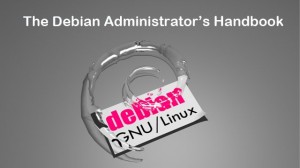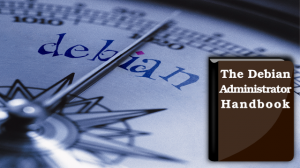This is my monthly summary of my Debian related activities. If you’re among the people who made a donation to support my work (130.30 €, thanks everybody!), then you can learn how I spent your money. Otherwise it’s just an interesting status update on my various projects.

Dpkg work
The month started with fixing newly reported bugs to prepare the 1.16.1.1 release:
- #644492: there was a flaw in a change I made to the trigger setup code. This resulted in packages being incorrectly marked as configured while they were only unpacked in a new chroot.
- #642656: dpkg-source’s refusal to build when it detects unrecorded changes broke the (mostly unused, except by the lintian test suite apparently) “2.0” source format.
- #644412: the Makefile snippet “buildflags.mk” did not respect the new maintainer specific environment variables (like DEB_CFLAGS_MAINT_APPEND) because make does not forward environment variable through
$(shell …). Fixed that by manually exporting the required variables. - I also disabled dpkg-buildpackage’s output of the build flags since it was confusing several maintainers. dpkg-buildpackage invokes debian/rules and it has no (clean) way to discover the build flags changes that maintainer request by setting the dedicated environment variables in debian/rules. Maintainers expect to see the build flags with the modifications they have requested and not just the default values set by the distribution.
With the help of Guillem, we decided on a proper fix for a race condition sometimes triggered by parallel builds when 2 concurrent dpkg-gencontrol try to update debian/files (see #642608). This ended up requiring a new package (libfile-fcntllock-perl) that the Debian perl team kindly packaged for us. With all this sorted, it was a rather easy fix.
Multiarch progress
I also spent lots of time on multiarch. I fixed an old bug that requested to support the multi-arch paths in case of cross-building (see #595144), the discussion was not really conclusive on which of the two proposed patches was better so I ended up picking my own patch because it was closer to how we currently deal with cross-building. Then I fixed 2 issues that have been reported on Ubuntu’s dpkg. The first one (LP #863675) was rather severe since an installed package ended being “disappeared” in favor of its foreign counterpart that was removed (but that had some config files left). The second one (LP #853679) only affected dselect users (apparently there are still some!) who had a self-conflicting library (Provides: foo, Conflicts: foo) installed for multiple architectures.
But the bulk of the time spent on multiarch has been spent discussing with various parties on how to go forward with multiarch. The release team commented on the schedule of the merge to ensure it makes it into Wheezy, and the Debian project leader also commented on the problems encountered so far.
While not the best course of action I could have hoped for, it certainly helped since Guillem started pushing some reviewed commits. Out of the 66 commits that were in my pu/multiarch/full branch one week ago, 20 have been merged in the master branch already.
Python-django security update and RC bug
Since python-django’s maintainer did not manage to prepare the required security updates, I stepped in and prepared version 1.2.3-3+squeeze2 for Squeeze and 1.0.2-1+lenny3 for Lenny. Unfortunately this security update is an example of how an inactive maintainer is likely to result in a severe delay for the release of security updates.
Furthermore in this specific case, the security team did not want to release the Squeeze security update until the Lenny one had been investigated (which required some time since upstream no longer supports the version in Lenny) but they did not make this very clear.
Later another release critical bug had been filed against the package (#646634) but after investigation, it turned out to be a local configuration problem so I downgraded it. I still forwarded the test suite failure to upstream authors since the test could be enhanced.
In any case, co-maintainers for python-django are welcome. I really preferred the situation where I can quietly sit down as backup maintainer… 🙂
WordPress packaging
WordPress sounds similar to python-django. I’m also “only a backup maintainer” but Giuseppe has been inactive for many months and I had to step in August because I wanted the new upstream version. I discovered a bit late that I was not subscribed to wordpress’ bugs and thus the release critical bug #639733 (that I introduced with my new upstream version) went unattended for a rather long time. Once aware, though, I quickly fixed it.
I also took the opportunity to start a discussion on debian-devel about how to deal with embedded javascript libraries and proposed a mechanism of “opportunistic replacement with symlinks”. WordPress is my testbed package for this mechanism, you can check out its debian/dh_linktree that implements the replacement logic.
The discussion has not been very interesting but at least I learned that Debian now requires that each source package shipping minified javascript files includes the original files too. It’s somewhat of a pain since it’s not a license requirement in many cases (many of those libraries are not under the GPL), but just a Debian requirement that many upstreams are not complying with. WordPress is affected and Jakub Wilk thus opened #646729 which is going to be a long-standing RC bug. To give good measures, I spent several hours investigating the case of each javascript file in the WordPress source package and I filed a new ticket on the upstream bugtracker.
Dropbox packaging work
A few months after the introduction of nautilus-dropbox to Debian and Ubuntu, I can say that the decision to only support the download of dropbox in the postinst has been a mistake. Because of this decision I had to make the postinst fail if the download failed. Even if the error message is relatively clear, this lead to many (mostly automated) bug reports on the Ubuntu side. Various other problems cropped up on top of this (trying to start dropbox while the package was not configured would result in an error because the user did not have the required rights to install the software, reinstalling the package while dropbox was running would result in a failure too, etc.).
I have fixed all those issues in the version 0.7.0-2 of the package. Now if the user has to install dropbox, it will use PolicyKit to request the root rights. The postinst will no longer fail if the dropbox download fails since it can be run later by the user. And I fixed the download code to remove the replaced file before unpacking a new file (insead of overwriting the existing file). All this work has been forwarded upstream.
The Debian Administrator’s Handbook Update
I’m glad to tell you that the translation will happen because we reached the minimal funding goal on October 22th with the help of 380 supporters.

Now the fundraising continues, but this time the goal is the liberation of the resulting book. For this to happen, we need to reach 25000 EUR in the liberation fund. So far we’re at 37% of this goal with 9400 EUR in the liberation fund (which means that 59% of the money raised has been put in the liberation fund).
Click here if you want to contribute towards the liberation of this book.
With (less than) 27 days left, it’s going to be a challenge to meet the goal, but we do like challenges, don’t we?
Misc work
- I filed #644486 against dh-make so that new packages have proper support of dpkg-buildflags from the start.
- I merged lots of patches from Luca Falavigna in the developers-reference.
- I discussed debtags integration in the PTS with Enrico Zini and Paul Wise.
- I updated publican’s packaging for the new upstream version 2.8. I had to write a new patch that I forwarded upstream.
- I filed an upstream bug on hamster-applet because just running hamster-time-tracker no longer brings its window forward.
Thanks
See you next month for a new summary of my activities.
 If you checkout
If you checkout 